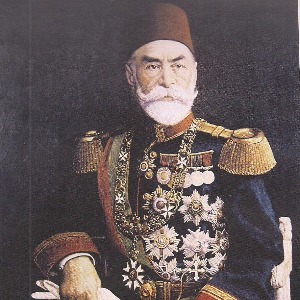
Grand Vizier, Marshall, War
Veteran, scholar (B. November 1st, 1839, Bursa/Turkey - D. January
21st, 1919, İstanbul, Turkey). He was the son of İpekçi Halil Efendi. He was the
father of Mahmud Muhtar Pasha (received surname Katırcıoğlu after the
Surname Law) who was the Minister of Maritime Affairs in the Ottoman
period and Sermet Muhtar Alus who was the journalist, writer and cartoonist known with his writings and books on Istanbul. His father passed away
when he was six years old and he was brought up by his grandfather. He completed his primary and secondary school
education in Bursa. After
graduating from Bursa Military Senior High School,
he continued his higher education at War
Academy in Istanbul on 1860. He graduated as a staff
captain in Istanbul.
He fought in Montenegro
battles next to Serdar-ı Ekrem Ömer Pasha. He conquered Ustruck Pass with a
small cavalry troop during the war. Despite the fact that he has wounded, he
held the pass until the arrival of supporting forces. Due to this success, he was
promoted as a commander. Later, he worked as a teacher at the School of
Artillery Staff and Military Engineering. He was sent to Germany and France to
do research on modern weapons by Abdülhamid II. On November 19th,
1888, while he was a colonel he became a mechanical teacher at Mekteb-i
Mülkiye-i Şâhâne İdâdîsi (Civil Service High School). After
he remained in office for twelve years, he left this position. He was one of
the founders of Cemiyet-i Tedrisiyye-i İslamiye (Society of the School for
Orphans). In 1864, he started to train Yusuf İzzeddin Efendi, the son of Sultan
Abdülaziz. He made trips to Great Britain, France, Germany and Austria together
with the prince between the years of 1864-67. In 1867, he returned to
Montenegro and achieved a great success against the Montenegrins. He was
appointed to Yemen in 1869 and due to the successes gained against the Arab
revolts in Yemen, he was promoted to the rank of general at the age of 33
(1871). Then, he was appointed as the
governor of Yemen. Afterwards, he served for Ottoman Empire in Shumen, Erzurum,
Bosnia-Herzegovina and Montenegro. Before the 1877-78 Ottoman-Russian War, he
was put in charge of the supreme military commander of the Caucasian Front by
Abdülhamid II. Under his command, Ottoman army won Gedikler Battle on 25th
August and Yahniler Battle on 24th October against the Russians.
After these victories, he was upgraded to the rank of Marshall and then
received the title of Ghazi (T.N. war veteran). He formed a line of defense in
Zivin to defend Erzurum province. As the Ottoman Army commanded by him was defeated
in the Battle of Alacadağ; the army withdrew to Erzurum. Although he had much
less military force fighting against the Russians; he achieved to repulse the
Russian armies several times in Aziziye Bastion. He asked Istanbul to send
support troops, but when this request was rejected, he decided to draw the
Caucasian Army towards Bayburt. Meanwhile, he was called to Istanbul upon the
coming of Russian armies, which were fought in the Danube Front against the
Ottoman troops under the command of Gazi Osman Pasha and he was charged with
forming a line of defense in Çatalca against the Russians troops. When the
meetings of the Treaty of San Stefano began with Russia, he pulled up to the
line of defense to Bakırköy. In the last days of the war, he was appointed to
the presidency of general staff. After the Ottoman-Russian War, he assumed the
directorship of the Tophane-i Amire (T.N. a place
in which the cannon balls for Ottoman army and the navy were produced); governorship
of Monastery and inspector of the Ottoman Third Army. Between the years of
1882-1908, he stayed in Egypt with the title of “Extraordinary Commissioner”
for twenty six years. Before the Balkan War (1912-13), he became a Grand Vizier
during the reign of Mehmet Reşat the 5th, but this was a short-lived
mission (July 22th, 1912 - October 29th, 1912). Upon the
outbreak of Balkan Wars, the 4th Parliament (Meclis-i Mebusan) was
dissolved and martial rule was declared on August 5th, 1912. On October
29th, 1912, he resigned from his position as grand vizier.
Following the war,
Ahmed Muhtar Pasha published his memoirs in a book named “Sergüzeşt-i Hayatım’ın Cild-i Sanisi”. Because he was interested in
astronomy and mathematics; he suggested use of the Gregorian calendar system
and international hour system. Besides the book on this subject named “Islahat-ül
Takvim” (T.N. Reforming the Calendar), he has many scientific works. The railway
station that was opened in 1890 on the European side of Istanbul; initially was
called with his name, but later it became known simply as the Sirkeci Train
Station.
Died in 80 years old in
Istanbul, Gazi Ahmed Muhtar Pasha was buried in the courtyard of Fatih Mosque.
The mansion that was used as headquarter by the Ottoman troops during the
1877-78 Ottoman-Russian War, was restored and transformed into a museum by the
governor of Kars. In the museum, there exist the military equipments, battle
plans, maps and photographs related to the Ottoman-Russian War Museum. There is
also a statue of Ahmed Muhtar Pasha in the museum entrance.
MAIN WORKS:
Güzide-i Tarih-i Osmani (1883), Riyaz ül-Muhtar: Mirat-ül Mikat ve el-Edvar (1885), İstimdad (1887), Islah-ül Takvim (1891), La Réforme du Calendrier (1893), Rehber-i Umran (1900), Rehber-i Muzafferiyat-i Bahriye yahut Deniz ve Sahil Muharebelerinin Vesait ve Kavaid Esasiyesi (1900), Hikmet-i Tefekkür - Mensur: Mecal-i Fikret - Manzum (1902), Atabe-i Bülend Mertebe-i Hazret-i Hilafet Penahiye Bir Arıza (1910), Sergüzeşt-i Hayatımın Cild-i Evveli (1912), Sergüzeşt-i Hayatımın Cild-i Sanisi (1912), Sene-i Maliyenin Hicri Sene-i Şemsiye ile İstibdaline Dair (1912), Takvimü’s-sinin (1915), İstimali Tekerrür Eden Takvim-i Malî (1916 Serair ül-Kur’an (1920).